The term Châteauneuf-du-Pape (CNDP) refers to the village and the appellation. It also refers to the wines from the appellation surrounding the village - some of which are the finest and most long-lived red wines in the world.
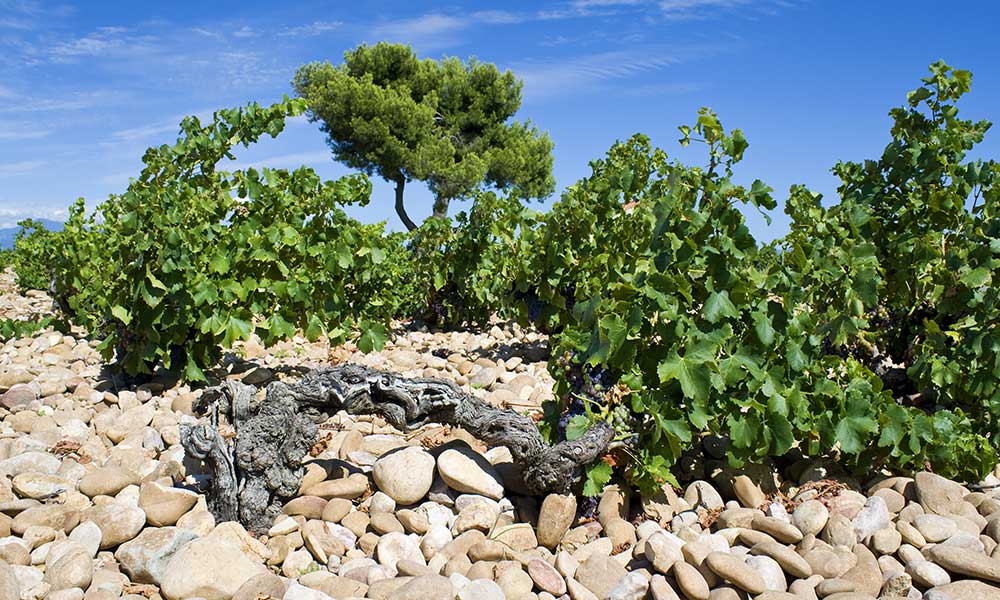 CNDP vineyards are famous for their galets roulés, or large pebbles, which retain heat and assist in fruit ripening.
CNDP vineyards are famous for their galets roulés, or large pebbles, which retain heat and assist in fruit ripening.
Roughly translating to ‘the Pope’s new castle’, the history of CNDP is indeed bound up with Popes. The papacy moved to Avignon from Rome in 1308 and the seven successive popes reigned there from 1309-1377. Pope John XXII is credited with planting a papal vineyard and the wines from that area were initially known as ‘Vin du Pape’ and later as Châteauneuf-du-Pape. These days you’ll find CNDP wine in a distinctive heavy bottle embossed with the papal insignia.
The appellation covers about 3,100 ha and a total of 18 varieties, both red and white. But in the warm climate and poor soil of CNDP, grenache reigns supreme, producing the finest examples of this variety in France. The other main red varieties here are mourvèdre, syrah and cinsault. White CNDP is also made but in very small quantities.
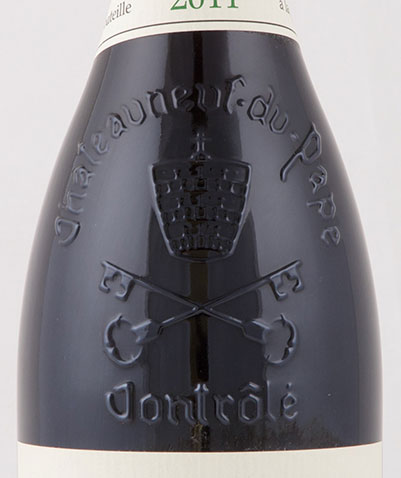 The vineyards of CNDP are relatively flat and traditionally characterised by the famous and much photographed galets roulés, or large pebbles, which retain heat and assist in the fruit ripening process. Despite the fixation on the stones, the appellation actually possesses a variety of soils.
The vineyards of CNDP are relatively flat and traditionally characterised by the famous and much photographed galets roulés, or large pebbles, which retain heat and assist in the fruit ripening process. Despite the fixation on the stones, the appellation actually possesses a variety of soils.
Unusually for one of France’s great wine regions, CNDP has no official classification system (like the grand and premier cru system of Burgundy) to identify superior vineyard sites. Some domaines have created their own classification by producing special cuvées.
So what can you expect from a good red CNDP? Wine author Andrew Jefford rather poetically describes it: “The best is unique within French wine. A grandly soft wine, deliciously burdened with a sweetness and spice like a cedar whose branches are laden with snow. It’s a wine to welcome drinkers at 2 or 3 years yet its flurry of goosedown tannin and meaty extract will hold two decades at bay.”
Robert Parker gets equally carried away: “Its glorious perfume, which is reminiscent of an open-air produce market in a Provençal hill town, expansive, generous, well-endowed flavours, sumptuous texture, and heady alcohol content evoke an image of hedonism.”
Keeping it simple, I’d describe red CNDP as a rich, round, generous and full-bodied wine that’s spicy and alcoholic. It has the potential to be long-lived and silky, but can still be enjoyed when young and lush. Common flavour descriptors include: cherry, raspberry, kirsch, violets, herbs and black pepper.
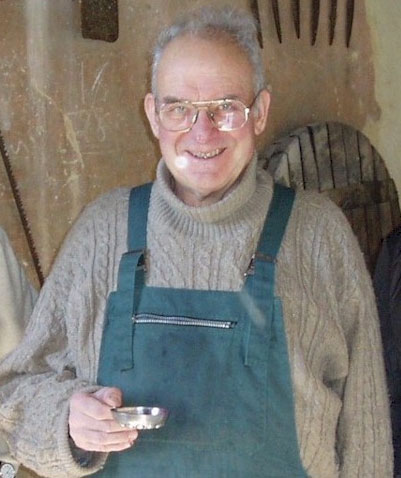
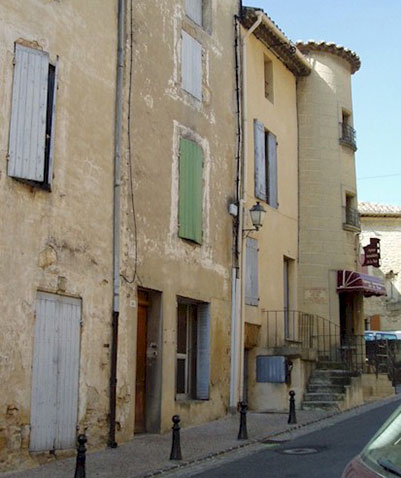 Henri Bonneau.
Henri Bonneau.
Left: Henri Bonneau was famously modest and preferred a simple lifestyle. And below: Monsieur Bonneau's estate and cellars in the building with the green shutter, dating from the 17th century.
Back in 2014, I offered the wines of Henri Bonneau, describing him as nothing short of a living legend in Châteauneuf-du-Pape - his wines some of the most sought after.
“...the Bonneau wines rest alone at the absolute summit of the appellation, and to a certain degree, they transcend it in much the same way that Château d’Yquem does in Sauternes.” John Gilman, View from the Cellar.
“Bonneau portrays a zest for life and the sweet nectar that comes out of the barrels could come from nowhere else. You realize how lucky we are, as wine lovers today, to have the access to a gentleman like Henri Bonneau and to be able to taste his wines. They won’t exist forever.” Jeb Dunnuck, The Wine Advocate, Oct 2013.
At the time I noted that without a 13th generation to carry the Bonneau legacy, we were privileged to see his extraordinary wines. This comment took on greater significance when Bonneau died just a few years later at the age of 77. Tributes flowed from respected wine critics and news outlets around the world.
“Henri Bonneau, an acclaimed producer of Châteauneuf-du-Pape, whose wines were as renowned for their almost otherworldly beauty, complexity and intensity as they were rare and hard to find, died on March 21.” New York Times, March 2016.
Bonneau was born in 1938 and was the 12th generation of his family to produce wine in CNDP. He left school at 14 to help his father in the vineyard and made his first wine in 1956. As Wine Spectator observed, he ‘quietly assumed the position of dean of CNDP’ and became regarded as the master traditionalist, using methods harking back to the 19th century. There’s no producer more revered in the appellation.
Domaine Henri Bonneau is a tiny estate of only 15 acres, a good part of which lies in CNDP’s most famous vineyard, ‘La Crau’. Bonneau only made a limited number of red wines, usually 4, with grenache accounting for about 90% of his plantings. Mourvèdre, counoise, vaccarèse and syrah made up the balance. He made his wines in the most simple and traditional way, but what really set him apart was his élevage. This French term does not really have a direct equivalent in English, however it refers to the practices that take place between fermentation and bottling. In Bonneau’s case this involved extended aging in what can only be called a hodgepodge of ancient barrels. Bonneau blended and bottled his wine at such time he thought fit - with the wines spending up to 5 years in barrel and not being released until 6, 8 or even 10 years of age!
Bonneau’s house and cellars date from the 17th century and are located in the town of CNDP. Memorably described by one critic as ‘like the bio-hazard room in a video game,’ to someone like me, who’s worked in hygiene conscious Australian wineries, they’re simply mindboggling! I’m not sure how best to describe them. I’ll let the pictures do the talking.
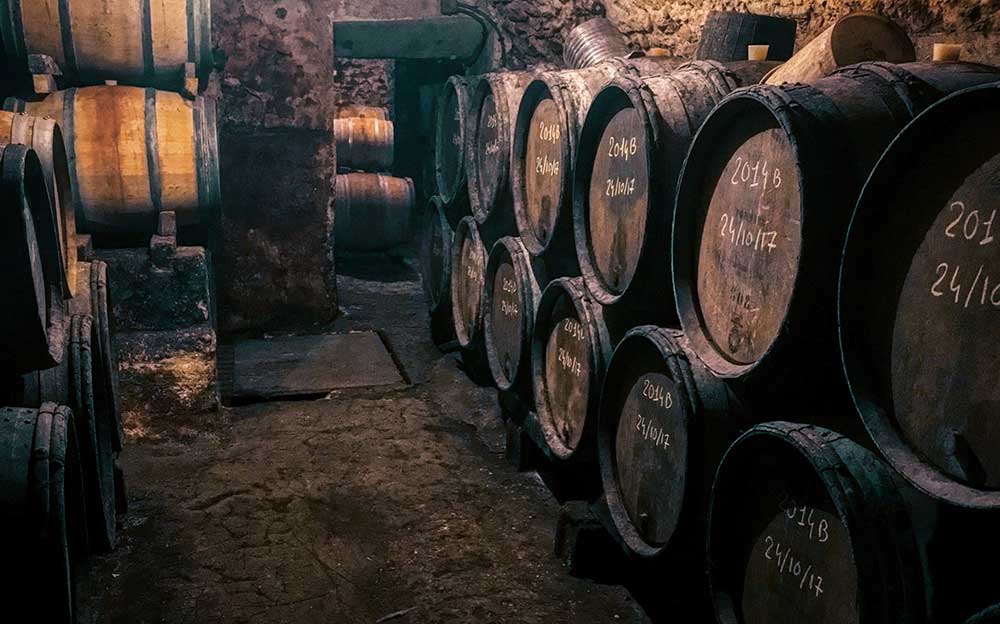 Despite his fame, Bonneau was a modest man who lived an unassuming and simple life. He had a reputation for being standoffish, as acclaimed British wine author Andrew Jefford can attest: “I have tried to visit Châteauneuf’s Henri Bonneau but was told that Monsieur Bonneau does not receive English journalists!”
Despite his fame, Bonneau was a modest man who lived an unassuming and simple life. He had a reputation for being standoffish, as acclaimed British wine author Andrew Jefford can attest: “I have tried to visit Châteauneuf’s Henri Bonneau but was told that Monsieur Bonneau does not receive English journalists!”
Following his death, the estate was taken over by Bonneau’s long-standing commercial partner Daniel Combin who appointed Régis Charmasson to run things on a day-to-day basis. Given the length of élevage at the estate, many of the ‘post-Bonneau’ wines are still in barrel, so it’s too early for the critics’ judgement, but I reckon it’ll be pretty hard for anyone to replicate Bonneau’s unique and eclectic mind-set and techniques.
Being a fan of Bonneau, I purchased on release, and patiently held onto several of the last vintages he produced, assiduously storing them in temperature-controlled conditions.
With his final vintage, 2015, released a few months ago, I’m excited to finally offer this wonderful collection of wines to you. This is truly a unique and highly collectable offering, containing some of the region’s most highly prized and rarest wines.
Henri Bonneau Réserve des Célestins
This is Bonneau’s ‘grand vin’, his top wine, only released in good years. The wine is about 90% grenache with the remaining 10% made up of mourvèdre, counoise and vaccarèse. Most of the fruit comes from the Le Crau and Grand Pierre vineyards (sandy soils next to Chateau Rayas). It's a remarkable wine that’ll stop you in your tracks.
“Henri Bonneau’s Réserve des Célestins is his greatest wine, and unequivocally the single greatest wine made in Châteauneuf du Pape today. In the old days it had its rivals, when Jacques Reynaud still was alive and making his magical elixirs at Château Rayas, or when Château de Beaucastel, Vieux Telegraphe, Château Fortia or Château la Nerthe were experiencing their salad days of greatest achievement. But today the Bonneau Réserve des Célestins sits alone at the summit, a lonely beacon of brilliant terroir and impeccable winemaking.” John Gilman, A View From The Cellar.
 Henri Bonneau Réserve des Célestins 2010
Henri Bonneau Réserve des Célestins 2010
One of the great all-time vintages of CNDP. Wine Spectator gives the 2010 vintage 98 points as does Robert Parker’s Wine Advocate.
“Schedule to be bottled next week (I suspect it will be in bottle by the time you read this), the 2010 Châteauneuf du Pape Reserve des Celestins is a sensational effort. Deeper, richer and more concentrated than the Marie Beurrier, it reveals an unusually inky ruby/purple color to go with overflowing notes of kirsch liqueur, roasted meats, crushed flowers, garrigue and just about every other Provençal spice you could name. Full-bodied, beautifully concentrated, layered and a blockbuster-styled effort, it should surpass the 2007 and possibly rival the 1990. This is a tour de force in Châteauneuf du Pape!” 97-99 points, Robert Parker’s Wine Advocate, Oct 2015.
I can offer it for $999 a bottle (1 bottle)
 Henri Bonneau Réserve des Célestins 2011
Henri Bonneau Réserve des Célestins 2011
“The 2011 Châteauneuf du Pape Reserve des Celestins shows the sunny warmth of the vintage with its killer perfume of sweet red and black fruits, pepper, smoked herbs and Provençal garrigue. Medium to full-bodied, sexy and with ripe tannin, it's not a blockbuster, but is about as Provençal as it gets. It will drink nicely right from the get-go and I suspect not shut down.” 93-95 points, Robert Parker’s Wine Advocate, Oct 2015.
“Bright ruby-red. Far more expressive than the Marie Beurrier, displaying a wild array of candied red fruits, flowers and Asian spices, along with an intense mineral overtone. Silky, sweet and pure on the palate, offering intense raspberry preserve and spicecake flavors and a jolt of lavender pastille. Closes long and sweet, with building spiciness and smooth, harmonious tannins that sneak up late.” 93-95 points, Stephen Tanzer’s International Wine Cellar, April 2015.
I can offer it for $750 a bottle (2 bottles)
 Henri Bonneau Réserve des Célestins 2012
Henri Bonneau Réserve des Célestins 2012
“This defines old school, with savory detail and notes of roasted chestnut, fresh tobacco leaf, cedar and brick dust leading off, backed by a core of currant, cherry and plum fruit flavors that is lightly dried yet nonetheless fresh and racy in feel. Singed juniper and bay leaf hints score the finish. Likely to hold just like this for some time. Best from 2020 through 2040. 400 cases made.” 97 points, James Molesworth, Wine Spectator, Nov 2018.
“The 2012 Châteauneuf-du-Pape Reserve des Célestins is gorgeous stuff and has everything you expect from this estate. Black currants, garrigue, beef blood and ground pepper all give way to a ripe, sexy and full-bodied beauty that has sweet tannin. I’m quite sure Henri would snub his nose and call the wine too easy, in his gregarious way, but count me as a fan.” 96 points, Jeb Dunnuck, Oct 2017.
I can offer it for $799 a bottle (2 bottles)
 Henri Bonneau Réserve des Célestins 2014
Henri Bonneau Réserve des Célestins 2014
“A vintage Henri always loved, so the new administration has reproduced Henri's father's label and placed ‘Hommage à Henri Bonneau’ on it, as a kind of collector’s item. Much silkier than the Marie Beurrier with lovely acidity and sense of finesse. An underrated vintage. It has a lovely driving tanginess with a touch of volatility that gives grip and liveliness. At late maturity this should become quite Pinot-esque. Drinking Window 2021 – 2034.” 95 points, Matt Walls, Decanter, Oct 2020.
“In contrast, the 2014 Châteauneuf du Pape Reserve des Célestins is a significant step up and has ample density and depth, as well as medium to full-bodied richness; the wine has lots of sweet kirsch and cherry fruits, garrigue and peppery aromas and flavors. In addition, the tannin is sweet and polished, and it has more concentration, depth and richness than most in the vintage.” 92-94 points, Jebb Dunnuck, The Wine Advocate, Oct 2016.
I can offer it for $865 a bottle (3 bottles)
 Henri Bonneau Réserve des Célestins 2015
Henri Bonneau Réserve des Célestins 2015
The last Celestin made by Henri Bonneau and a true collectable.
“Looking at the barrels designated for the 2015 Châteauneuf du Pape Reserve Célestins, which always comes from the famed la Crau lieu-dit, it offers a big, mouth-filling, chewy profile as well as classic dark fruits, garrigue, pot roast, pepper and cured meats aromas and flavors. It has lots of tannin, but everything is perfectly ripe, and this is a sensational looking effort. It’s worth noting that this will be the last wine ever vinified by Henri, and it certainly looks to be a fitting tribute to an incredible winemaker.” 95-97 points, Jeb Dunnuck, The Wine Advocate #227, October 2016.
“Beginning to show a floral side, this is very smooth and silky on the palate, just starting to show some toasty, demerara sugar development. A powerful style, quite butch, needs time. Drinking Window 2024 – 2035.” 96 points, Matt Walls, Decanter, Oct 2020.
“A clear step up over the Marie Beurrier release, the 2015 Châteauneuf-du-Pape Reserve des Célestins was the star of the show on this occasion, and this tannic, full-bodied beauty would no doubt be loved by Henri. Cassis, earth, garrigue, licorice and assorted black fruits all emerge from this deep purple-colored effort and it’s tannic, structured and deep.” 94-96 points, Jeb Dunnuck, October 2017.
I can offer it for $899 a bottle (3 bottles)
I can also offer:
Henri Bonneau Châteauneuf du Pape:
“In many ways, the regular bottling from Henri Bonneau is perhaps my favorite… It is a great example of Châteauneuf du Pape in my book, and a wine that is of great worth to search out and secure whenever it pops up, as it drinks decidedly sooner than the top two Bonneau bottlings (usually coming into full bloom about eight years out from the vintage), but ages very gracefully.” John Gilman, A View From The Cellar.
 Henri Bonneau Châteauneuf du Pape 2010
Henri Bonneau Châteauneuf du Pape 2010
No reviews, however 2010 was regarded as one of the all-time great vintages in the southern Rhône. Wine Spectator gives the 2010 vintage 98 points as does Robert Parker’s Wine Advocate.
I can offer it for $450 a bottle (2 bottles)
 Henri Bonneau Châteauneuf du Pape 2011
Henri Bonneau Châteauneuf du Pape 2011
“The classic 2011 Châteauneuf du Pape is a sexy, medium-bodied, sunny wine that’s loaded with notions of garrigue, kirsch, incense and fruit cake aromas and flavors. While I suspect it will be on a relatively fast evolutionary track, the fact is that these long elevage, which are the MO at this estate, result in a stable, age-worthy wine, even in forward, charming vintages such as 2011. Still, don’t hesitate to enjoy this in its youth.” 90-92 points, Jeb Dunnuck, Robert Parker’s Wine Advocate, Oct 2016.
I can offer it for $399 a bottle (2 bottles)
Henri Bonneau Cuvée Marie Beurrier
This wine was named after Bonneau’s wife’s aunt.
“Monsieur Bonneau’s Cuvée Marie Beurrier bottling is a decidedly deeper and more powerful wine than his regular Châteauneuf du Pape, and plays the role of La Tâche in the Bonneau cellars to his Réserve des Célestins’ Romanée-Conti (of course within the strapping and powerful idiom of Châteauneuf). To my palate this is the most classic expression of Châteauneuf du Pape magic in the Bonneau cellars.” John Gilman, A View From The Cellar.
 Henri Bonneau Marie Beurrier 2010
Henri Bonneau Marie Beurrier 2010
“A sensational vintage here, the 2010 Chateauneuf du Pape Cuvée Marie Beurrier may be the finest vintage ever for this cuvée. Beautifully textured, full-bodied, thick and unctuous, it offers soaring notes of kirsch, crushed flowers, garrigue, melted licorice and spice. Softer and more rounded than the Celestins (and from when I tasted it last year), it's one sexy Chateauneuf du Pape that shows the class of this incredible vintage.”
93-95 points, Jeb Dunnuck, Robert Parker’s Wine Advocate, Oct 2015.
I can offer it for $599 a bottle (2 bottles)
 Henri Bonneau Marie Beurrier 2011
Henri Bonneau Marie Beurrier 2011
“The 2011 Châteauneuf du Pape Cuvée Marie Beurrier is similar in style, yet just a touch more reserved and tight, with a more serious feel in its black cherry, saddle leather, pepper and meaty bouquet. Medium-bodied to full-bodied, nicely balanced and fresh, it seems much more reserved than I recall from last year, but possibly it’s just due to following the much more open, sexy, classic cuvée.” 90-93 points, Robert Parker’s Wine Advocate, Oct 2016.
I can offer it for $499 a bottle (2 bottles)
 Henri Bonneau Marie Beurrier 2014
Henri Bonneau Marie Beurrier 2014
“There will be a single cuvée in 2014 and the 2014 Châteauneuf-du-Pape Marie Beurrier is a pretty, spice-filled wine that has Burgundian style in its texture, medium-bodied richness, integrated acidity and fine tannin. This estate has a history of excelling in so-called off years and this should be rock solid.” 92-92 points, Jeb Dunnuck, Oct 2017.
“This is finessed but not terribly complex. It is beginning to take on some development with a good sense of freshness and acidity. Elegant if not deep. Drinking Window 2021-2026.”
94 points, Matt Walls, Decanter Oct 2020.
I can offer it for $599 a bottle (3 bottles)